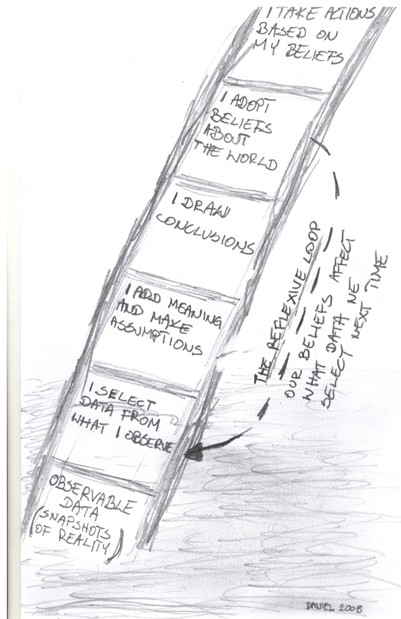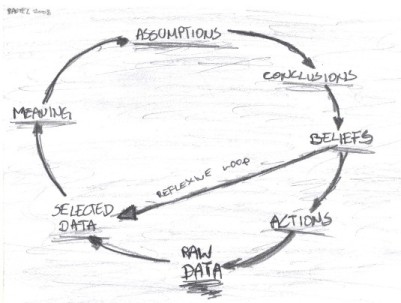 Here it is. Famous ladder of inference, by some creative members of our group called also ladder of influence or even ladder of innocence (?!?!). By the time it was presented to us, I found it kinda fuzzy. But now, when I really went thru again and did some net research it turned to be slightly different. I believe it is great tool for self control and it could also be great early warning system for your daily actions. Inside the post I will try to remind you what it’s all about. Due to copyright issues I did graphics myself – sorry for that.
Here it is. Famous ladder of inference, by some creative members of our group called also ladder of influence or even ladder of innocence (?!?!). By the time it was presented to us, I found it kinda fuzzy. But now, when I really went thru again and did some net research it turned to be slightly different. I believe it is great tool for self control and it could also be great early warning system for your daily actions. Inside the post I will try to remind you what it’s all about. Due to copyright issues I did graphics myself – sorry for that.
Surfing the Net over the weekend, I found one thing which fairly describes why this tool could be useful. This is a golden phrase by Ronald Laing and I like it very much:
The range of what we think and do is limited by what we fail to
notice. And because we fail to notice that we fail to notice,
there is little we can do to change, until we notice how failing
to notice shapes our thoughts and deeds
This gentleman was a Scottish psychiatrist who wrote extensively on mental illness and particularly the experience of psychosis, but I still like it. OK, now let’s get down to business. What is ladder of inference? This is a model, which allow us to reflect reality in the very efficient form. So where do we start? As always with ladders, we have to start at the bottom. There is data. It has no value, it’s just there, all of it. Simply as photo-camera would capture them. This is just a snapshot of reality. Then, we enter the stage and we start the whole thing. We look at data and we do select these, which we think might be useful for us and we ignore the rest at the very same moment. Having “our” data picked up, we add a meaning to them, which, by definition, influence the data. So now, we have data and we know what do they mean, so we are drawing conclusions out of them and based on that we build our beliefs. Since that moment on, this is our fix. This is how, we believe, things work. This is our point of view and mental model of reality. Now, having all this “know-how”, we are ready to last step – to take actions.

Tricky thing is this reflexive (reflective?) loop, which you can see on the sketch. We have already our own way of perceiving reality (data) and those beliefs will affect, which data are we going to select next time. Last step of this ladder, brings us all the way down, because actions will create new data, and the process will start over again. This shows the reinforcing nature of the process, which can be shown also as below:

That’s it in a nutshell. Try too use it to analyse your own behaviour and remember, that when you are saying “this is a fact”, you are referring to what you think is a fact. Avoid competency traps – what has worked fine once, does not have to work in other cases. So, do not jump to conclusions to quickly. Try to analyze!
The Ladder of Inferencewas presented in Overcoming Organizational Defenses by Chris Argyris and The Fifth Discipline Field Book by Peter Senge and colleagues.
Admin do you want unlimited content for your blog? Serarch in google:
Nysrisar’s tool
If you are interested in topic: earn online money free usenet access – you should read
about Bucksflooder first